Discover the modern reemergence of the original Templar Order, which survived by direct legal succession since 1307 AD, fully restored to sovereignty under international law in 2013 AD.
 The Sovereign Magistral Order of the Temple of Solomon is the direct lineal continuation of the 12th century historical institution of the original Knights Templar from 1118 AD. The modern Templar Order has been legally and canonically restored to the full depth and substance of its ancient and medieval heritage, and to its original legitimacy as a chivalric, nobiliary and ecclesiastical institution.
The Sovereign Magistral Order of the Temple of Solomon is the direct lineal continuation of the 12th century historical institution of the original Knights Templar from 1118 AD. The modern Templar Order has been legally and canonically restored to the full depth and substance of its ancient and medieval heritage, and to its original legitimacy as a chivalric, nobiliary and ecclesiastical institution.
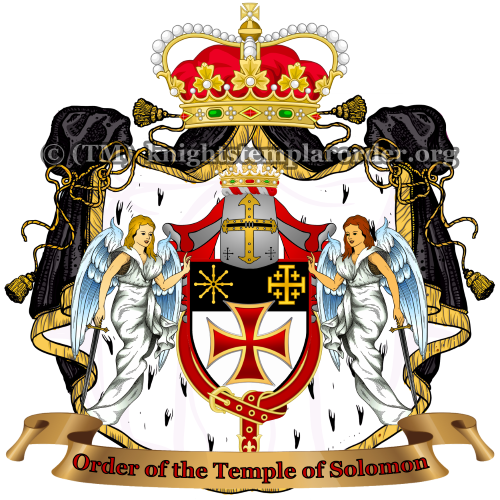
Official heraldic coat of arms of the Government of the Templar Order as a non-territorial Principality and sovereign subject of international law
The facts of this Restoration, and the historical, doctrinal and legal continuity of the original Order, are presented in full detail throughout these materials. Complete and verifiable evidence is provided publicly, from primary sources, as academic source references, in the extensive numbered footnotes.
The Arthurian legends of the Holy Grail, written by the Templars themselves [1] [2], preserved the chivalric ideals and esoteric values of the Templar Order, and carried its knightly and priestly reputation as “warrior monks” into the present day.
Its popularity in literature and entertainment notwithstanding, the facts of its continued existence are no less real. Just as well-known facts of the historical record prove its accomplishments, a wealth of little-known but verified facts of “lost history” (now “found”) also prove the reality of the survival, restoration and public reemergence of the original Order into the modern era.
The Restoration of the Order of the Temple of Solomon, reestablishing its authentic status of public legitimacy, was successfully accomplished through laborious efforts. This was not undertaken to discredit any Templar-themed organization, neither to claim any influence nor role in the various popular modern groups. Rather, this was intended to provide the practical support of infrastructure and legal capacities of international scope, with revitalizing new infusions of ancient Templar sacred knowledge and scholarship. These resources can be openly shared to advance the collective interests of all Templar groups with maximum global impact.
All revival groups have a place and a role within the overall movement of cultural Templarism. This principle is the basis for the modern mission of outreach and reciprocal cooperation, with a policy of non-interference and mutual respect for necessary rights of autonomy. All Templar groups which genuinely represent goodness, lawfulness, human rights and justice are welcome to connect with and benefit from the support of the original Order of the Temple, while maintaining their own independence.
As a result, all who sincerely desire to live the True Life of Chivalry, as a practical way of life of great relevance and profound significance in the modern era, can now “come home” in Brotherhood and Sisterhood, under the banner of the most famous Order in recorded history, within the fortress of its official capacities of statehood as a sovereign subject of international law.
Popularly known as the “Knights Templar”, this historic institution profoundly influenced the development of civilization, both by its humanitarian missions, and through its distinctive culture of noble gallantry and scholarship. This is the legendary Order which played a prominent role in leading humanity out of the Middle Ages, and into the Renaissance.
The modern Templar Order is wholly dedicated to actively pursuing the same historical missions to uphold and advance human civilization. Those authentic missions are primarily based upon restoring – and applying – ancient knowledge, sacred wisdom and moral values in society, as the collective heritage of humanity.
Through these continued traditional missions, the essential motivation of the restored Templar Order is to lead humanity out of the Modernist decline of civilization, and into the New Renaissance of freedom, prosperity, human rights and the rule of law.
(Learn about the Foundations of the Order for its restoration.)



The Order of the Temple of Solomon is an Order of Chivalry. It is not a “fraternity” for social status, and is not for “title seekers” collecting honourary certificates. It is not a “business club” for commercial networking or self-promotion, and not a “power club” for political influence or control over others. It is not a “secret society” for promoting philosophies or elitism. It is not a “fan club” for knightly fantasies, and not a “revival group” for anachronistic entertainment. It is not a “haters club” against any other traditional religion or culture.
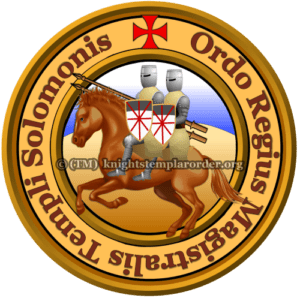

Grand Mastery Seal of the Knights Templar (1158 AD) “Two Horsemen” Seal
Rather, this restored medieval Order is based on monastic principles, dedicated to humble service in its historical missions of upholding good against evil, as Defenders of All Faith and Guardians of Justice for humanity. All members are required to make it their priority to support the authentic Templar humanitarian missions of the Order itself, and not to use the Order for their own private ambitions.
The 12th century Templar Order was never influenced by any “Priory of Sion” secret society, the claimed “Priory of Sion” medieval origins from Jerusalem parallel to the Templars were disproven by European universities as false “pseudo-history” [3] [4], and the modern “Priory of Sion” revival as a self-styled “Order” was disproven by French police and courts, exposed as a 20th century hoax based on criminal fraud and forgery [5] [6].
The Templar Order was never Masonic, and is not involved with the separate traditions of 15th century Freemasonry, a fraternity which correctly does not claim to be a chivalric order, and was founded 330 years after the Knights Templar [7]. It was never related to the infamous 18th century secret society of the so-called “Bavarian Illuminati”, which was formed a full 660 years after the Templar Order [8].
Any and all philosophies of secretive domination, elitist control or bloodline superiority fundamentally violate all genuine doctrines of Templarism, and find no place nor any tolerance within the Order of the Temple of Solomon. Note that inheritance of certain hereditary titles does not imply any superiority over the rest of humanity, and even hereditary rights can be revoked for wrongful misconduct [9].
True Chivalry is egalitarian meritocracy, and categorically excludes any “ego trips” or “power trips”. True Knights and Dames prefer a humble Quest to defend, uplift and inspire others, in the service of God.
The Temple Rule of 1129 AD from Saint Bernard, which remains the founding Charter of primary Templar doctrines, dedicates the Order to “the love of Justice which constitutes its duties” (Rule 2), requires to punish all wrongdoing “for the love of Justice” to protect the innocent (Rule 47), and commands to “take your rights” only as “specifically established” by law (Rule 57). It declares that “no person shall be elevated” (Rule 34), that “God holds both the strong and the weak equal” (Rule 38), and mandates that no person “strong or weak, who wishes to promote himself gradually… remain unpunished” (Rule 46). It commands that all Templars must be “without any arrogance and without any show of pride” (Rule 18), forbids any “pride or arrogance” (Rule 19), and declares that for one committing an offense “to pride himself in it” requires a “harsher punishment” (Rule 46). [10]
It is precisely for these reasons, and to remember these core doctrines, that all Templars strive to apply the historical Templar motto: “Non nobis, non nobis, Domine, sed nomini Tuo da gloriam”, from the Old Testament (Psalm 115:1), which translates as “Not to us, not to us, Lord, but to Thy name give the glory”. [11]
(Learn about Secret Societies Rejected by Templar core principles.)


Unique among all modern Templar-themed groups, the Order of the Temple of Solomon possesses fully documented legal legitimacy as a genuine Order of Chivalry [12] [13] [14] [15] [16], in strict accordance with all applicable historical rules of chivalric, nobiliary and sovereign institutions [17]. Those rules, which remain in full force as the doctrines of customary international law [18] [19] [20] [21], and are binding upon all countries [22], formed the backbone of the complete restoration of the original Templar Order.
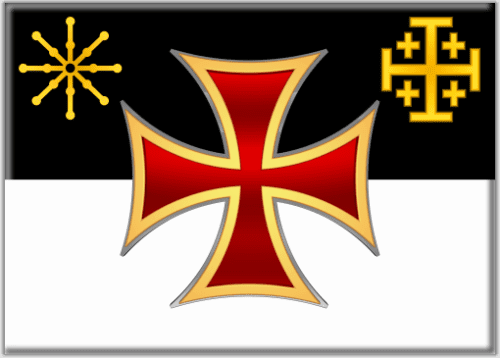

Official Flag of the Order of the Temple of Solomon as an independent non-territorial Principality and sovereign subject of international law
That legitimacy was fully restored by the historical legal doctrines of Juridical Continuity, Historical Continuity, Doctrinal Succession and Magistral Succession [23], all ensuring the proper sovereign reestablishment of the Grand Mastery [24] [25]. The Order was thereby reconnected with all three sources of its original authorities: Ecclesiastical, Royal and Sovereign. The resulting official legitimacy was based upon, and entirely facilitated by, possessing the full depth, scope and detail of the original substance of the historical Order of the Temple of Solomon.
That restoration of official status legally reconnected the Templar Order with its most important 12th century source of authority: The little known (and much overlooked) Papal Bull Omne Datum Optimum of 1139 AD, by which the Vatican granted the Templar Order full Sovereign Protection of independent sovereignty as a non-territorial Principality:
This Papal Bull is explicitly permanent and irrevocable, granting “in perpetuity… the Protection and Tutelage of the Holy See for all time to come”, such that its independent authority “may not be infringed nor diminished by any ecclesiastical or secular person.” It describes the Order specifically as a “Princely house [principali domo]… [with] dependencies”, meaning a sovereign Principality of statehood, regardless of territory.
Strongly emphasizing that it is unconditionally irrevocable, the Papal Bull further declared that “If anyone, with the knowledge of this our decree, rashly attempts to act against it… he shall lose the dignity of his power and honor”, making any attempt to revoke it legally null and void. [26] The resulting diplomatic privileges and immunities were reconfirmed by two other supporting Papal Bulls, Milites Templi of 1144 AD [27] and Militia Dei of 1145 AD [28].
Vatican scholars documented that the Templar Order did in fact possess and exercise that independent authority, as non-territorial sovereign Principality, although it did so quietly and privately, only in its relations with other historical institutions [29] [30]. Evidencing that the Order also possessed its own inherent ecclesiastical sovereignty from the Ancient Priesthood of Solomon, Vatican records confirm that autonomous Templar Chaplains had exclusive authority to perform all sacraments within the Order [31].
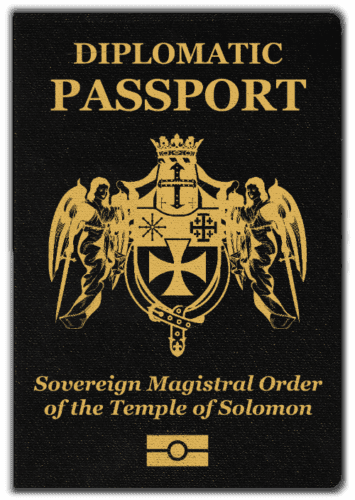

Diplomatic Passport of the Order of the Temple of Solomon as a non-territorial Principality and sovereign subject of international law
As a non-territorial sovereign Principality of independent statehood in its own right, the modern Templar Order legally holds the status of a “sovereign subject of international law” [32] [33], based upon its legal legitimacy, authentic substance, and institutional capabilities to advance its historical purposes internationally [34].
The Order thereby inherently possesses full Diplomatic status for official international relations [35] [36].
The Templar Order is recognized as a government with statehood as a “non-territorial Principality and sovereign subject of international law” in diplomatic relations, as a founding Member State of the “Order of the Temple of Solomon Foundation” (since 2014), which is recognized as an “Inter-Governmental Organization” (IGO) by United Nations Registration No. 646065.
By its legalized official status as a sovereign Principality of statehood, the Order of the Temple of Solomon fully possesses its own inherent Fons Honourum of Crown authority, which is vested in the institution itself, in its own right [37] [38] [39]. This gives the Templar Order legal capacity to officially grant titled knighthood and damehood in nobility, and to create titled nobility of peerage, with full legitimacy under customary international law.
On these legal bases, the Templar Order holds sovereign legitimacy of its own constitutional parliamentary Government, which consists of the Grand Mastery supplemented by Ministers as Crown Officers. Maintaining strict historical continuity, the Temple Rule of 1129 AD remains the primary Charter of the chivalric aspect of the Order [40] [41]. The Constitution is enacted as the statutes of the Government for the sovereign aspect of the Order in international law, and is thus secondary to the basic doctrines of the Temple Rule.
(Learn about Templar Legal Succession continuing sovereignty.)


Note that the phrase “Knights Templar” is only a common informal description, and “Templar” is only a descriptive adjective. Neither the word “Knights” nor “Templar” were ever part of the authentic name of the original historical institution as an official Order of Chivalry:
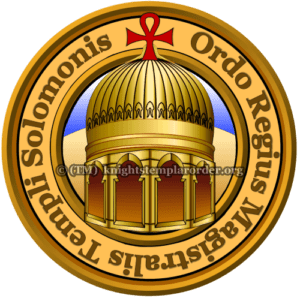

Grand Mastery Seal of the Knights Templar (1118 AD) “Temple Mount” Seal
As documented by a contemporary Bishop in 1145 AD, the Knights Templar “call themselves the Knights of the Temple”, meaning the Temple of Solomon [42]. The 19th century British Barrister (courtroom lawyer) and historian Charles G. Addison confirmed that the historical name of the Templars was the “Knighthood of the Temple of Solomon” [43]. By customary chivalric and heraldic law, a legitimate “knighthood” is properly called an “Order” of Chivalry, such that the only official name is “Order of the Temple of Solomon”. The 12th century Cathars thus formally called it “the Order of the Temple” of Solomon [44] [45].
In the Temple Rule of 1129 AD, the original constitutional Charter of the Order later ratified by the Vatican, the Templars are described as an “Order of Knighthood”, with Brothers or Knights “of the Temple”, more formally called “Order of the Temple”, and most completely named “Order of the Temple of Solomon” (Rule 51, Rule 65, Rule 66). [46]
The official name of an Order of Chivalry can include a preceding “style” (analogous to styles of address for nobiliary titles), determined by rules of customary international law, which can be used to indicate the particular legal status of an Order:
The style “Sovereign” is exclusively for an Order which is “an independent non-territorial power”, possessing sovereign statehood in international law [47] [48]; The style “Magistral” is exclusively for a Religious Order with a Sovereign Grand Master which is governed by a Grand Mastery and continues by constitutional Magistral Succession [49].
Therefore, the full, official and authentic name of the modern restored Templar Order is “Sovereign Magistral Order of the Temple of Solomon”. The proper Latin name is thus “Ordo Regius Magistralis Templi Solomonis”.
(Learn about the Templar Survival Lineage into the modern era.)


Full restoration – and the public reemergence – of the historical Order of the Temple of Solomon was the result of nine years of intensive work (2007 – 2016 AD), applying the collective lifetime works of multiple scholars and curators. This project was diligently conducted by an international group of surviving Templars of lineal succession for direct continuity, led by Western European historians and archaeologists for authentic heritage, assisted by Eastern European geopolitical strategists for sovereign statehood, backed by two international law firms for strategic infrastructure, and further supported by university departments for quality of substance of the Order.


Wax Seal of the Sovereign Magistral Order of the Temple of Solomon
Those nine years of modern restoration directly mirrored (indeed even repeated) the original nine years of the first Templar Knights, restoring the Ancient Priesthood from the Temple of Solomon (1118 – 1127 AD) [50], as the foundation of the chivalric Order from its inception. Thus, the Order was restored in precisely the same manner in which it was originally founded.
As an integral part of this meticulous restoration, the Templar Order has fully restored, strictly maintains, and continually teaches, the historical rules and principles which governed the original Knights Templar, including: The Code of Chivalry of 1066 AD, the Temple Rule of 1129 AD, and the Templar Code of 1150 AD.
The Order has also restored and equally upholds the international standards which descended from and embody its own 12th century Templar traditions, including: The Rules of Courtly Dress & Regalia of 1672 AD, the Rules of Courtly Etiquette of 1682 AD, and the Rules of Courtly Titles & Forms of Address of 1769 AD.
As a result, all members of the modern Templar Order are empowered to reclaim the genuine heritage of the original Knights Templar, and to fully experience it as a “living tradition”. This unique resource is provided to all members, as a complete working system for living a genuine lifestyle of Chivalry, which is focused on practical real-world application in the modern era.
(Learn about Modern Templar Missions of the Order.)


As the legitimate continuation of the historical institution, the modern Templar Order has no concern for mere subjective opinions of what some people think “real” Templars supposedly “would”, “could”, “should”, or “must” have done in the past or do in the present.
Rather, the exclusive focus of the Order is on the concrete, undeniable evidence in the historical record, which proves what the historical Knights Templar did in fact do, and demonstrates how the genuine Templar way of life of Chivalry actually does directly translate into a practical lifestyle in the modern era.
In this way, the fully restored Order literally “makes history come alive” for all of its active members.
The Roman philosopher and statesman Marcus Cicero (106-43 BC) best expressed this timeless rule: “The first law of history, is not to dare to utter falsehood: The second, is not to fear to speak the Truth.” [51] [52]
Following that classical adage of Cicero, the legitimacy and heritage possessed by the restored Order of the Temple of Solomon, and its teachings to all members, are not derived from some mere “version” of history. The Order does not rely on any “secrets” of some “oral tradition” of history, and thus does not need to ask people to “believe” in its statements by its own authority.
Rather, the substance of the Templar Order is firmly grounded in documented facts, as preserved in public sources of the historical record. Abundantly proving this truth to the world, all statements and teachings of the Order, which could possibly be questioned as “unknown” or controversial, are solidly backed by full and proper academic source reference citations, of authoritative historical documents and scholarly works. This makes the accuracy of all such facts and quotes publicly verifiable from the original sources.
The Old Testament records the immortal words of the Biblical King Solomon: “The thing that hath been, it is that which shall be; … There is no new thing under the sun.” (Ecclesiastes 1:9) [53] This was famously paraphrased by William Shakespeare: “There be nothing new, but that which is hath been before… Oh that record could with a backward look, even of five hundred courses of the sun, show… in some antique book” [54].
Accordingly, as so eloquently stated by the US President Harry Truman: “The only thing new in the world is the history you don’t know.” [55] True to this timeless wisdom, there do exist strong and deep rivers of “lost history”, largely unnoticed by scholars and generally forgotten by humanity. Such “lost history” then becomes “secrets”, not because it was ever supposed to be hidden as secret, but only because it was left behind.
The New Testament of the Bible condemns the secrets of “men, who withhold the Truth in unrighteousness” (Romans 1:18-20), and declares that “Nothing is covered, that shall not be revealed” (Matthew 10:26-27), and “Nothing is secret… that shall not be known” (Luke 8:17). Jesus taught by example that the sacred knowledge must be taught to all who seek and are open to receive it (John 1:12). The Apostles taught that it is the will of God for “all men… to come unto knowledge of the Truth.” (I Timothy 2:3-4). [56]
Dutifully fulfilling this Biblical mandate, the modern Templar Order actively recovers and diligently restores key areas of “lost history” from the historical record. Through this work, the Order uncovers and reveals all “secrets” from its rich history, openly and publicly, returning them to the world as the collective heritage of humanity.
This knightly work empowers all peoples of the world to reclaim and resurrect the ancient sacred wisdom as the pillars of civilization, to ensure a fulfilling and prosperous future for all of humankind. In this way, living the life of authentic Templar Chivalry is to experience the power of “living history”, and to actively apply it in practice to solve the problems and challenges of the modern world.
(Learn about the Codes of Chivalry for Templar missions.)


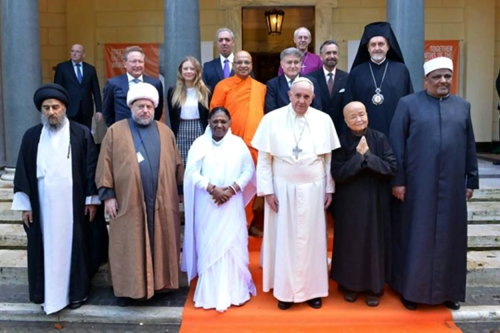

World faith leaders sign Universal Declaration Against Slavery, at the Vatican (02 December 2014). Including Sheikh El Tayeb (front 2nd from left), Grand Master of the Sufi Order in Luxor Egypt.
The same Temple Rule of Saint Bernard which makes the Order Christian as an institution, also made it authentically interfaith and non-denominational for individual membership, while still upholding its Ancient Christian traditions: It specifically includes “Secular Knights”, such that members can be from any religion, or no religion at all (Rules 65-66). One later rule (ca. 1150 AD) encourages Templars to attend religious services only “insofar as he is comfortable with it” (Rule 279). Another later rule (ca. 1250 AD) even allowed Templars to “enter into another religion” and remain in good standing (Rule 630) [58].
The reasons for this original policy of inclusiveness are: (1) The Ancient Solomonic heritage of the Order embodies the timeless foundations underlying all major spiritual religions, and unifying all Christian denominations; (2) To defend Christianity, it is necessary to defend all religious rights under law, which requires cooperation with all religions; and (3) Additional skills and resources of “Secular Knights” always strengthened the Order to most effectively defend Christianity.
While the Order actively defends the Church, it is not itself a Church, but rather an Order of Chivalry, which always included “Secular Knights”. The restored Templar Order will not suppress these proven facts of its original interfaith inclusiveness, certainly not for any modern political ideologies. Accordingly, the Templar Constitution authentically provides that all religious activities are separate from the chivalric side of the Order, and are thus optional for all Templar Brothers and Sisters.
All people of genuine spiritual dedication to any religious tradition, who seek to be inspired and empowered to pursue noble Quests of worthy historical missions, can benefit from joining the Order of the Temple of Solomon. This experience gives vitality, colour and meaning to life, in the service of humanity, as a defender, disciple and teacher of many millennia of collective human knowledge.
All who seek to experience the authentic heritage of the Templar way of life of Chivalry, whether from any Christian denomination, Celtic or Mystic tradition, ancient Eastern religion, or any form of genuine spirituality, are welcomed in the modern Templar Order. Templar Brothers and Sisters are encouraged to choose the style and form of worship of their personal preference, consistent with their preferred culture.
Notice: Templar interfaith cooperation rejects and prohibits the modern “ecumenical” trend of “mixing” and “blending” of religions, and requires strictly preserving the distinct and authentic heritage of each historical tradition separately.
(Learn about Templar Spirituality underlying Chivalry.)
(Learn about the Defenders of the Church role of the Order.)
[1] Alan Butler and Stephen Dafoe, The Warriors and the Bankers, Lewis Masonic, Surrey, England (2006), pp.56-57.
[2] Frank Sanello, The Knights Templars: God’s Warriors, the Devil’s Bankers, Taylor Trade Publishing, Oxford (2003), p.278.
[3] Dominic Selwood, Knights Templar III: Birth of the Order (2013), historian for Daily Telegraph of London, article.
[4] Ed Bradley, The Priory of Sion: Is The ‘Secret Organization’ Fact or Fiction? (27 April 2006), article from “60 Minutes” journalistic exposé, CBS News.
[5] Affaire Pelat: Le Rapport du Judge (8-14 January 1994), Le Point, No.1112, p.11; Philippe Laprevote, Note sur l’Actualite du Prieure de Sion, in Politica Hermetica (1996), No.10, pp.140-151.
[6] Ed Bradley, The Priory of Sion: Is The ‘Secret Organization’ Fact or Fiction? (27 April 2006), article from “60 Minutes” journalistic exposée, CBS News.
[7] Alan Butler and Stephen Dafoe, The Warriors and Bankers, Lewis Masonic, Surrey England (2006), pp.36-37, pp.78-79.
[8] Albert G. Mackey, Encyclopedia of Freemasonry, Richmond VA, Macoy Publishing (1966), p.474, p.1099.
[9] François Velde, Nobility and Titles in France, Heraldica (1996), updated (2003), “History of Nobility: Acquisition of Nobility”.
[10] Henri de Curzon, La Règle du Temple, La Société de L’Histoire de France, Paris (1886), in Librairie Renouard, Rules 2, 47, 57, Rules 34, 38, 46, Rules 18, 19, 46.
[11] Old Testament, Authorized King James Version (AKJV), Cambridge University Press (1990), Psalm 115:1.
[12] The British Crown, The Gazette (London Gazette), Her Majesty’s Stationery Office, London (16 January 2007), Issue No. 58221, p.541, “Other Notices”, Notice No. 999, legalizing and recognizing the “Independent Kingdom of Mann”; The London Gazette, published by royal authority of the British Crown, is legally “the official public record” of the United Kingdom since 1665 AD.
[13] Barrister’s Opinion, In Re The Kingdom of Man and the Isles, Pratchetts Solicitors, Peterborough (03 April 2007), witnessing that “before the [London Gazette] notice was published it was passed up to the Queen of England’s desk where it sat for four weeks until it was finally granted approval”.
[14] United Kingdom Parliament, Crown Office Act of 1877, Regnal 40 & 41 Victoria, Chapter 41 (10 August 1877), Section 3.3, evidencing that prior approval of a Gazetting Notice by the legal department of the British Crown constitutes a “royal proclamation” establishing a legal fact.
[15] HRH Prince David King of Mann, Royal Letters Patent: Sovereign Magistral Order of the Temple of Solomon, Royal House of the Independent Kingdom of Mann (03 April 2013).
[16] HRH Prince David King of Mann & MEH Prince Matthew of Thebes, Act of Completion and Cooperation, duly executed and ratified as a binding legal contract and sovereign treaty, Royal House of the Independent Kingdom of Mann & Sovereign Magistral Order of the Temple of Solomon (01 January 2015).
[17] International Commission for Orders of Chivalry (ICOC), Report of the Commission Internationale Permanente d’Études des Ordres de Chevalerie, “Registre des Ordres de Chivalerie”, The Armorial, Edinburgh (1978), Gryfons Publishers, USA (1996), including: Principles Involved in Assessing the Validity of Orders of Chivalry (1963).
[18] United Nations, Convention on Diplomatic Relations, Vienna (1961), UN Treaty Series, Volume 500, at p.95 et seq., Preamble, Article 47.1.
[19] United Nations, Convention on Consular Relations, Vienna (1963), UN Treaty Series, Volume 596, at p.261 et seq., Preamble.
[20] United Nations, Convention on Jurisdictional Immunities of States, New York (2005), UN General Assembly Resolution 59/38 of 02 December 2004, Preamble: ¶5.
[21] United Nations, Convention on the Law of Treaties, Registry Vol. 1155, No.18232, Vienna (1969), Preamble, Article 38.
[22] United Nations, Convention on the Law of Treaties, Registry Vol. 1155, No.18232, Vienna (1969), Article 38.
[23] Hans J. Hoegen Dijkhof, Hendrik Johannes, The Legitimacy of Orders of St. John: A Historical and Legal Analysis and Case Study of a Para-religious Phenomenon, Hoegen Dijkhof Advocaten, Universiteit Leiden (2006).
[24] Ambassadeur Géraud Michel de Pierredon, Histoire Politique de l’Ordre Souverain de Saint-Jean de Jerusalem (Ordre de Malte), Paris (1926), Tome 5.
[25] Saint Michael Academy of Eschatology, Regular Orders of the Holy See, West Palm Beach, Florida (2008), updated (2015), Free Course No.555: “Chivalric Orders”, Lesson 3, Part 4, “The Order After the Loss of Jerusalem to the French”.
[26] Pope Innocent II, Omne Datum Optimum (29 March 1139), translated in: Malcolm Barber & Keith Bate, The Templars: Selected Sources, Manchester University Press (2002), p.8, pp.59-64.
[27] Pope Celestine II, Milites Templi, “Knights of the Temple” (5 January 1144), translated in: Malcolm Barber & Keith Bate, The Templars: Selected Sources, Manchester University Press (2002), pp.8, 64-65.
[28] Pope Eugenius III, Militia Dei, “Knighthood of God” (7 April 1145), translated in: Malcolm Barber & Keith Bate, The Templars: Selected Sources, Manchester University Press (2002), pp.8, 65-66.
[29] The Vatican, The Catholic Encyclopedia (1911), The Encyclopedia Press, New York (1913), Volume 8, “Jerusalem”, p.363.
[30] The Vatican, The Catholic Encyclopedia (1912), The Encyclopedia Press, New York (1913), Volume 14, “Templars, Knights”, Part 2, “Their Marvellous Growth”, pp.493-494.
[31] The Vatican, The Catholic Encyclopedia (1912), The Encyclopedia Press, New York (1913), Volume 14, “Templars, Knights”, Part 1, “Their Humble Beginning”, p.493.
[32] Rebecca Wallace, International Law: A Student Introduction, 2nd Edition, Sweet & Maxwell (1986).
[33] United Nations, Convention on the Law of Treaties, Registry Vol. 1155, No.18232, Vienna (1969), Article 3.
[34] Vatican, Tribunal e Cardinalizi o Constituito con Pontifico Chirografo (10 December 1951), Acta Apostolicae Sedis (24 January 1953), XLV (15): 765-767.
[35] United Nations, Convention on Diplomatic Relations, Preamble; UN Convention on Consular Relations, Preamble; UN Immunities of States, Preamble: ¶5: All recognizing the “status of diplomatic agents” from all forms of nation states “since ancient times”, including historical sovereign entities of “differing constitutional and social systems”.
[36] United Nations, Convention on the Law of Treaties, Articles 3, 38: Status as a sovereign “subject of international law” is binding upon all countries regardless of recognition; UN Convention on Consular Relations, Article 47.1; UN Economic Rights of States, Preamble: ¶3, ¶7, Article 4: Countries “shall not discriminate” against a historical form of nation state.
[37] Hans J. Hoegen Dijkhof, Hendrik Johannes, The Legitimacy of Orders of St. John: A Historical and Legal Analysis and Case Study of a Para-religious Phenomenon, Hoegen Dijkhof Advocaten, Universiteit Leiden (2006), p.36.
[38] Hans J. Hoegen Dijkhof, Hendrik Johannes, The Legitimacy of Orders of St. John: A Historical and Legal Analysis and Case Study of a Para-religious Phenomenon, Hoegen Dijkhof Advocaten, Universiteit Leiden (2006), p.423.
[39] International Commission for Orders of Chivalry (ICOC), Report of the Commission Internationale Permanente d’Études des Ordres de Chevalerie, “Registre des Ordres de Chivalerie”, The Armorial, Edinburgh (1978), Gryfons Publishers, USA (1996), including: Principles Involved in Assessing the Validity of Orders of Chivalry (1963), Principle 1.
[40] François Velde, Legitimacy and Orders of Knighthood, Heraldica (1996), updated (2003), Section I, Part B-1, “Historical Continuity: Military-Monastic Orders”.
[41] François Velde, Legitimacy and Orders of Knighthood, Heraldica (1996), updated (2003), Section I, Part B-1, “Historical Continuity: Time Gaps”.
[42] Anselm, Bishop of Havelburg, Dialogi (1145), “Dialogus” to Pope Eugenius III, in Patrologiae Cursus Completus, Ed. J.P. Migne, Paris (1834-64), 188, col.1156.
[43] Charles G. Addison, The History of the Knights Templar (1842), pp.4-5, citing a Vatican document by Pope Urban IV (Jacques Pantaleon), the Latin Patriarch of Jerusalem, as “Pantaleon, Lib. iii. p. 82.”
[44] Keith Laidler, The Head of God: The Lost Treasure of the Templars, 1st Edition, Weidenfeld & Nicolson, London (1998), p.199.
[45] Piers Paul Read, The Templars: The Dramatic History of the Knights Templar, the Most Powerful Military Order of the Crusades, 1st Edition, Weidenfeld & Nicolson, London (1999), Phoenix Press, London (2001), Orion Publishing Group, London (2012), p.306.
[46] Henri de Curzon, La Règle du Temple, La Société de L’Histoire de France, Paris (1886), in Librairie Renouard: “Order of Knighthood” (Rules 2, 3, 12, 68); Brothers or Knights “of the Temple” (Rules 8, 12, 13, 26, 57, 62, 68); Formally “Order of the Temple” (Prologue Header preceding Rule 1, Primary Header preceding Rule 9, Rules 67, 68, 70); Officially “Order of the Temple of Solomon” (Rules 51, 65, 66).
[47] International Commission for Orders of Chivalry (ICOC), Report of the Commission Internationale Permanente d’Études des Ordres de Chevalerie, “Registre des Ordres de Chivalerie”, The Armorial, Edinburgh (1978), Gryfons Publishers, USA (1996), including: Principles Involved in Assessing the Validity of Orders of Chivalry (1963), Principle 6.
[48] Hans J. Hoegen Dijkhof, Hendrik Johannes, The Legitimacy of Orders of St. John: A Historical and Legal Analysis and Case Study of a Para-religious Phenomenon, Hoegen Dijkhof Advocaten, Universiteit Leiden (2006), p.292.
[49] Saint Michael Academy of Eschatology, The Chivalry: Classification of the Orders, West Palm Beach, Florida (2008), updated (2015), Free Course No.555: “Chivalric Orders”, Lesson 3, Part 2; “The Grand Master, Head of the Religion… [is] the holder of the Sovereignty… dependent on the Grand Mastership… [thus] jurists call this Chivalric Order ‘Magistral’”.
[50] Malcolm Barber & Keith Bate, The Templars: Selected Sources, Manchester University Press (2002), p.2.
[51] Marcus Tullius Cicero, De Oratore: Ad Quintum Fratrem Libri Tres, Northern Italy (55 BC), in the British Museum; Translated in: J.M. May & J. Wisse, Cicero on the Ideal Orator (De Oratore), Oxford University Press (2001), Book I, Part 2, Section 15.
[52] Saint Michael Academy of Eschatology, The Christian Chivalry: Classification of the Equestrian Orders in History and in Canon and Civil Law, West Palm Beach, Florida (2008), updated (2015), Free Course No.555: “Chivalric Orders”, Lesson 2, Part 3.
[53] Old Testament, Authorized King James Version (AKJV), Cambridge University Press (1990), Ecclesiastes 1:9.
[54] William Shakespeare, Shakespeare’s Sonnets, Thomas Thorpe, London (1609), Sonnet 59, Lines 5-10.
[55] Merle Miller, Plain Speaking: An Oral Biography of Harry S Truman, 1st Edition, Berkley Publishing Corporation (1974), p.179.
[56] New Testament, Authorized King James Version (AKJV), Cambridge University Press (1990): “For the wrath of God is revealed from heaven against all ungodliness and unrighteousness of men, who hold the Truth in unrighteousness… they are without excuse.” (Romans 1:18-20); “For there is nothing covered, that shall not be revealed; and [nothing] hid, that shall not be known.” (Matthew 10:26-27) “For nothing is secret… that shall not be known” (Luke 8:17); Jesus taught by example: “as many as received him, to them gave he power [of knowledge]” (John 1:12); The Apostles taught: “For this is good and acceptable in the sight of God… who will have all men to be saved, and to come unto the knowledge of the Truth.” (I Timothy 2:3-4)
[57] Henri de Curzon, La Règle du Temple, La Société de L’Histoire de France, Paris (1886), in Librairie Renouard, Rule 1, Rule 2, Rule 8, Rule 9, Rule 274.
[58] Henri de Curzon, La Règle du Temple, La Société de L’Histoire de France, Paris (1886), in Librairie Renouard, Rules 65, 66, Rule 279, Rule 630.
You cannot copy content of this page
